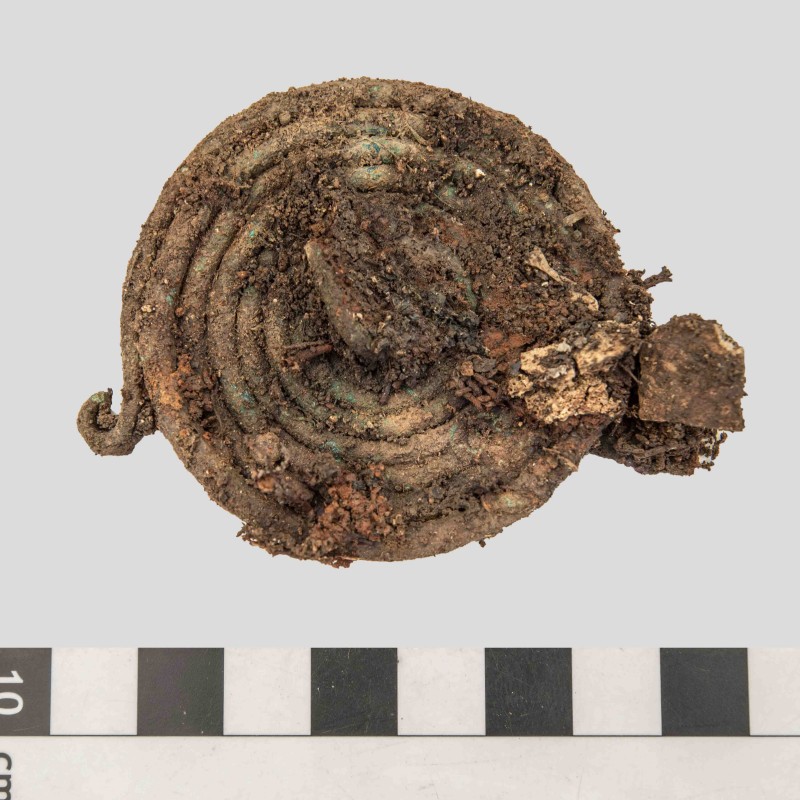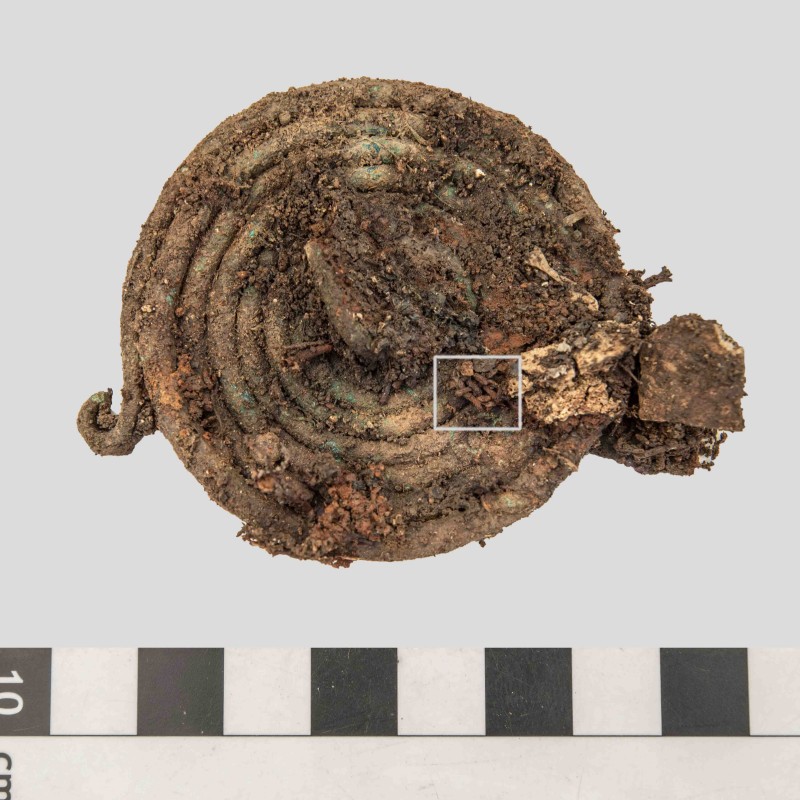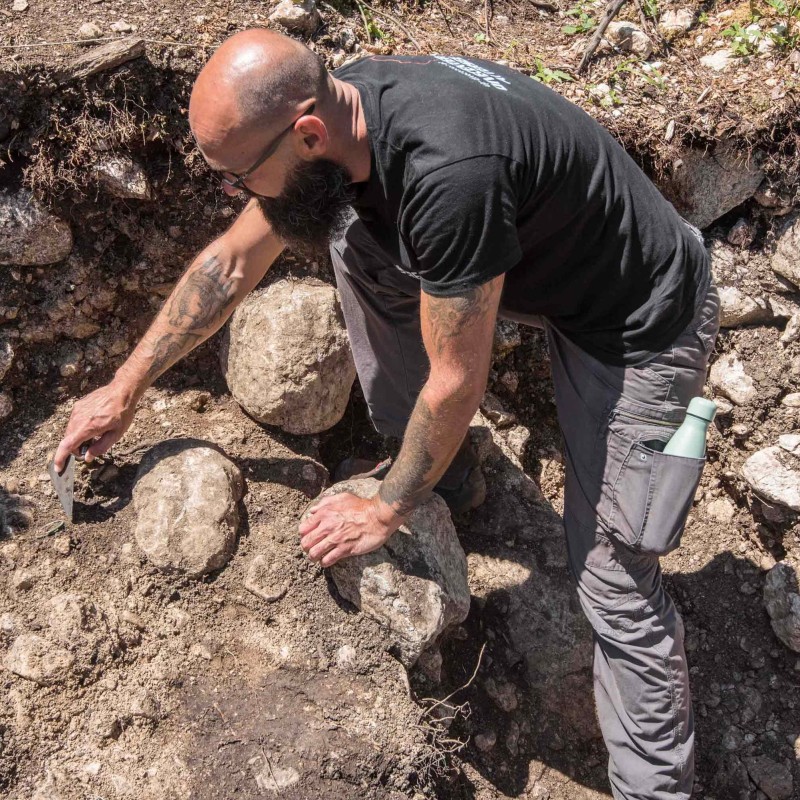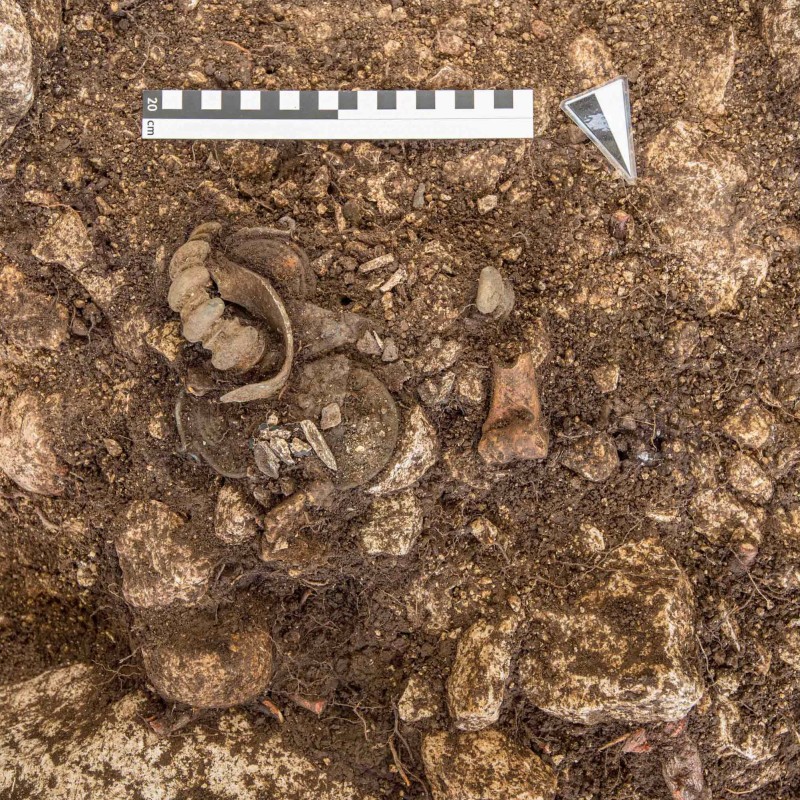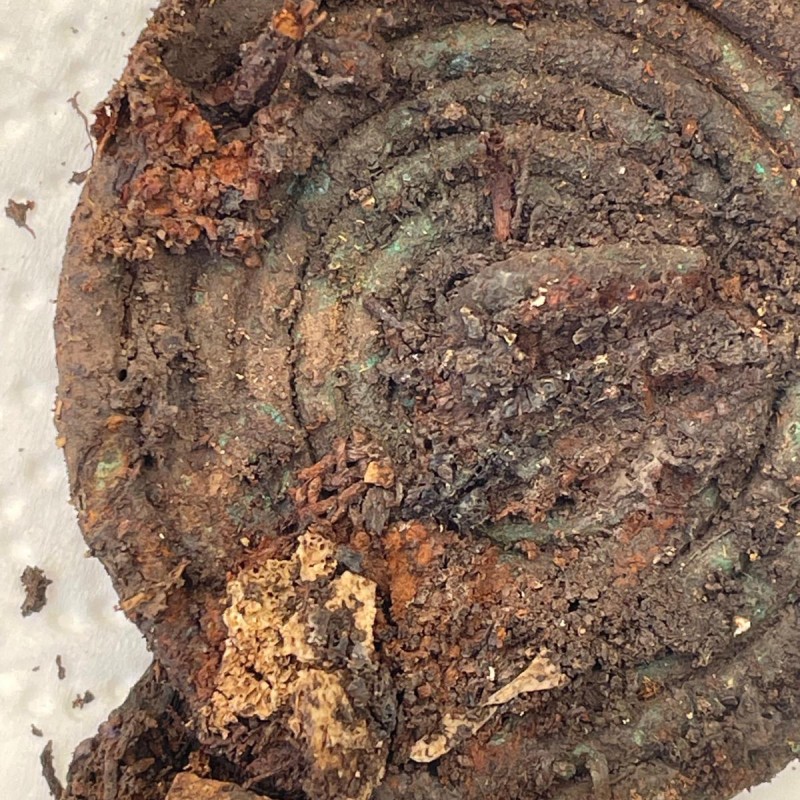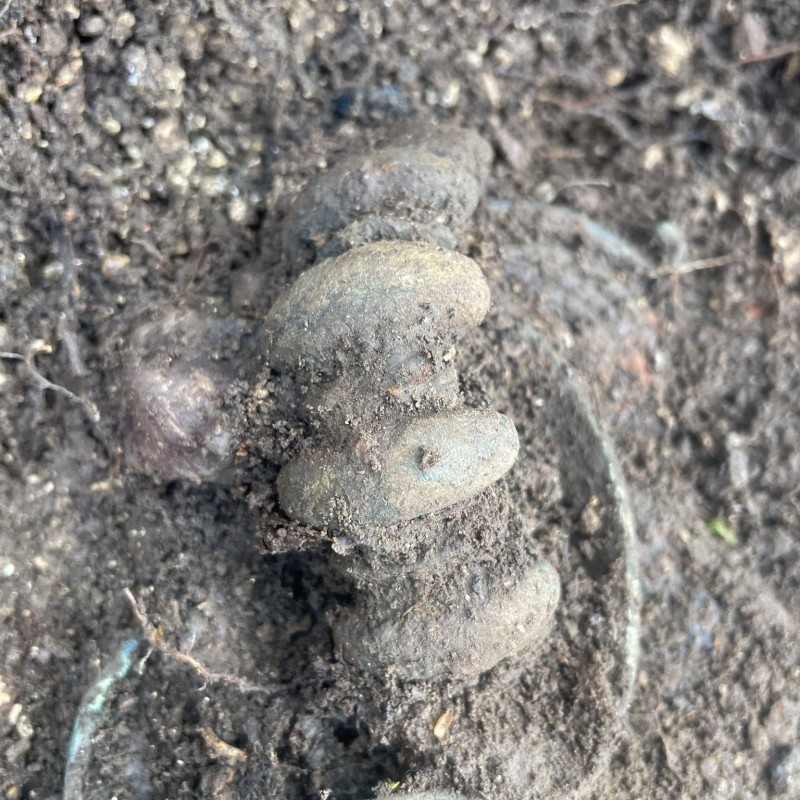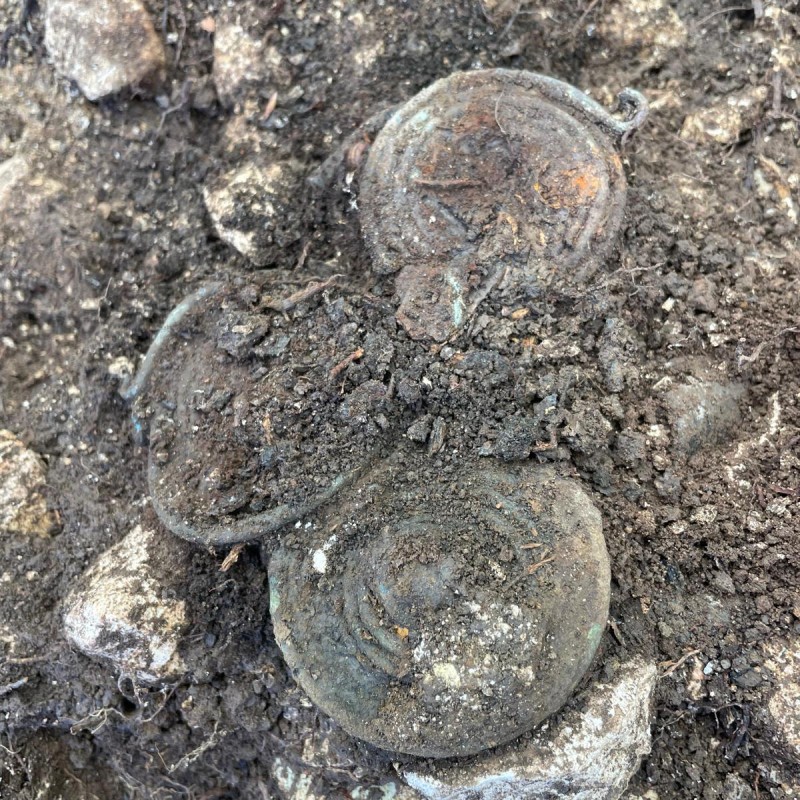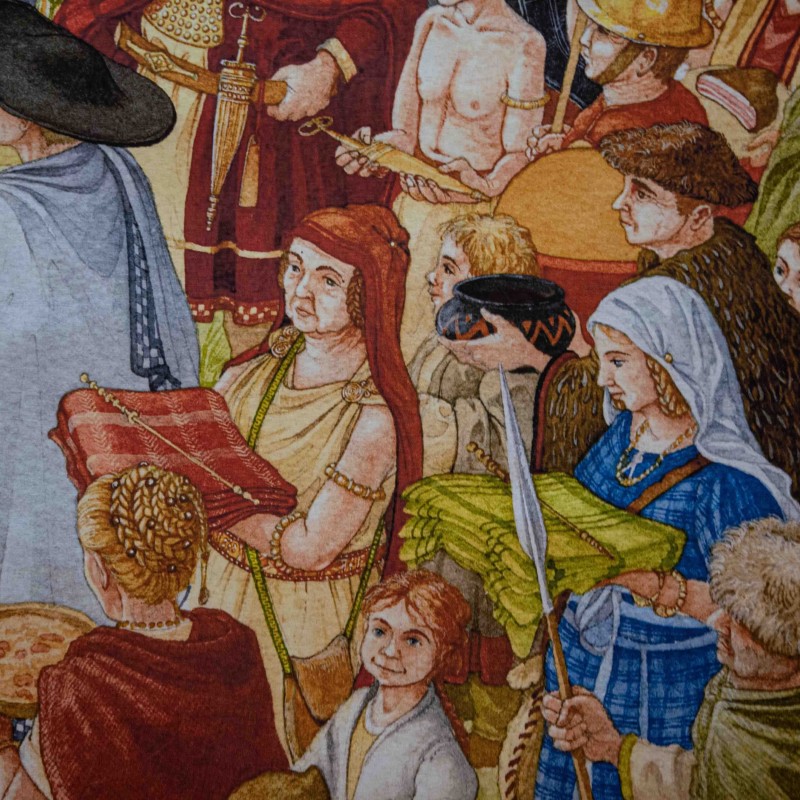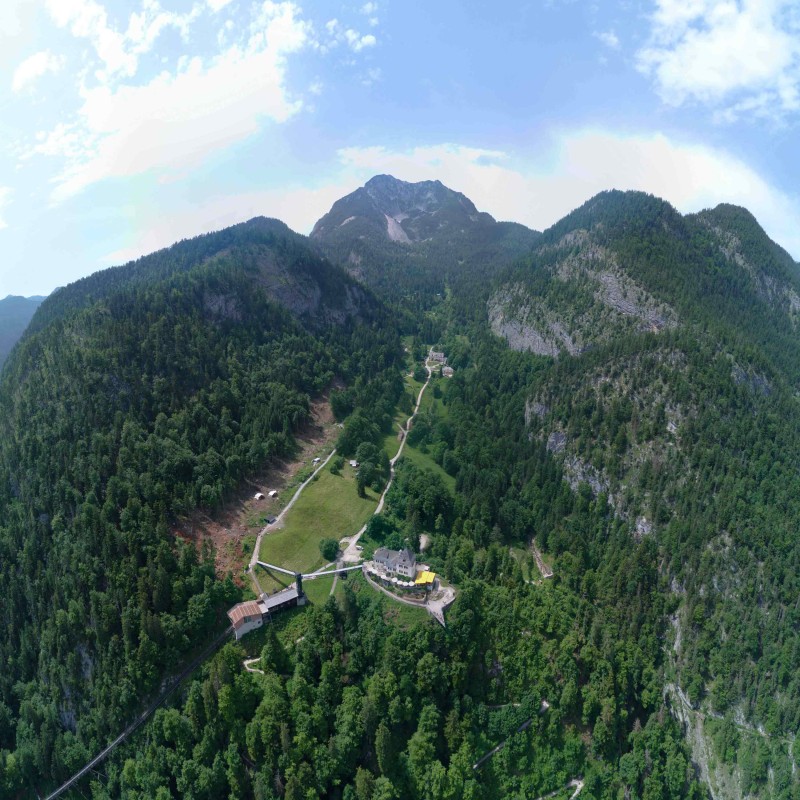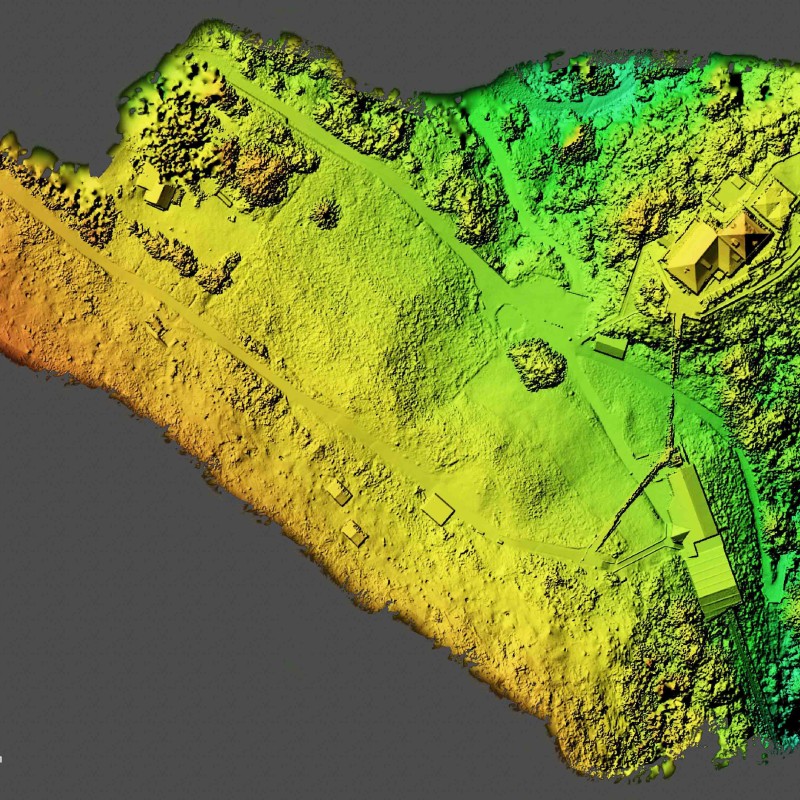Hallstatt - new early Iron Age grave discovered
05. July 2023
Bronze burial objects and textile
remains found in a newly discovered prehistoric cremation grave at the Salzberg in Hallstatt. The burial ground is larger
than previously assumed.
In the course of the NHM’s current excavation campaign at the Hallstatt Salzberg, archaeologists
have unearthed many new finds. The most remarkable among them is a cremation grave with very well preserved bronze burial
gifts. During the expert recovery of the metal finds, the researchers discovered amazingly well preserved fabric remains.
“The great state of preservation of the costume and jewellery in the grave is not the only remarkable aspect,” explains Johann Rudorfer, research assistant at the Prehistory Department of the NHM Vienna and head of the archaeological surface excavations, “we are also excited about having been able to find a clearly identifiable burial pit. While large parts of the area were investigated by archaeologists in the 19th century, the researchers of that time did not pay a great deal of attention to certain details, including grave structure.”
The Upper Austrian torrent and avalanche control authority is currently erecting a rockfall barrier to protect the town of Hallstatt from rockfalls. This construction project runs across the Iron Age burial ground that was discovered in 1846 by the manager of the salt mine, Johann Georg Ramsauer (1795-1874), who then then conducted systematic archaeological investigations until 1863.
Ramsauer discovered around 1,000 graves with copious amounts of burial objects, most of which ended up in Vienna. Extensive protocols, grave descriptions and maps have survived from his excavations, as well as many watercolour plates with grave systems and types of finds. It was thanks to Ramsauer’s meticulous work, especially the precise records of the rich burial objects, that the site of the find became eponymous for an entire epoch of European cultural history, the Hallstatt Culture.
The archaeologists are now taking the current building project as an opportunity to reopen and review the 19th century investigations of the Iron Age burial ground.
Given the location of the new grave, the archaeologists conclude that it was not identified or excavated earlier and has therefore been fully preserved in situ.
Burial objects found in the grave include a massive, ribbed bangle that was probably worn on the upper arm. Other bronze objects include spirals of thin wire found lying on a heap of cremated remains, which probably were parts of fibulae, i.e. fastening brooches. The researchers also found the blade of a bronze knife with traces of a wooden handle still adhering to it, and a piece of sheet iron, which they consider to have been part of a belt fitting, as well as an animal bone, which is the remnant of a food burial gift. The researchers are of the opinion that all objects were intentionally broken or bent and that this may have been prescribed by the burial rites of that time: “Perhaps people considered it appropriate to destroy the burial gifts in a ritual so that they could be used in the realm of the dead,” Johann Rudorfer notes, “since the body was also 'destroyed' by the cremation.”
The truly sensational new discovery only became apparent during recovery of the finds: when the archaeologists meticulously detached each piece individually from the densely packed ensemble, they identified clear imprints of a fabric on the undersides of the spiral discs, which had been preserved in the soil in the course of a lengthy mineralisation process. This might provide the first evidence that an organic container was used for placing the cremated remains in the ground. Urns were common in other cemeteries of the Hallstatt and early Latène periods in use at the same time, but they have only rarely been found in Hallstatt. “Usually we only find a small heap of bone fragments and some ashes, but the heaps are so compact that we have always suspected people used small pouches made of cloth or leather. This find probably constitutes proof of that theory,” Rudorfer notes happily.
Although only one per cent of the area cleared by the Upper Austrian torrent and avalanche control authority for the new rockfall protection barrier is being investigated by archaeologists, the digs have still provided valuable insights. “We now know, for instance, that the old excavations by no means covered all the graves on that burial ground. The way finds that were not transported to museum facilities were handled also becomes clear as we encounter further stray finds and individual heaps of human bones from inhumation burials. These items were removed from the graves after recording them on drawings and then deposited in the ground in close proximity,” adds Rudorfer.
Situated in the high valley above Hallstatt, this is one of Europe’s most important prehistoric burial grounds. So far, more than 1,500 graves have been uncovered and documented. The large number of burial gifts found, including magnificent vessels, weapons and jewellery, testify to the prosperity and far-reaching trade relations that were the result of salt mining and trade. Previous estimates spoke of 5,000 burials in the lower part of the Salzberg high valley. This number is likely to increase considerably given the evidence of even higher grave density identified during the most recent excavation.
While the burial ground is well documented, relatively little is known about the evolution of human settlement at the Hallstatt Salzberg. In the context of the NHM Vienna's annual research excavation, which is being carried out at another location in the high valley with the support of Salzwelten and Salinen Austria AG, the researchers are trying to establish a complete record of a deep-lying ensemble of timber buildings from the Late Bronze Age (1,200 - 800 BC) beneath the graves. On this site, the area under investigation will be successively expanded in the coming years, and the research team will probably uncover more graves that were established there much later. All this goes to show that the investigations on the Iron Age burial ground are far from complete. On this as on other sites, modern excavation and documentation methods will enable the researchers to find more answers to as yet unanswered questions.
Research contact:
Johann Rudorfer
Department of Prehistory, NHM Vienna.
phone: +43 (1) 52177 -
johann.rudorfer@nhm-wien.ac.at
https://hallstatt-research.com/
Educational programme together with the Hallstatt Salt Worlds
Watching archaeologists work
Until 4 August 2023 - Monday to Thursday, 10:00 a.m. to 4:00 p.m.
Hallstatt 7000: Looking over the archaeologists' shoulders – surface excavations
Visit our excavations at the prehistoric burial ground. The scientists of the Natural History Museum Vienna will be happy to let you look over their shoulder and tell you about their exciting research work in the Hallstatt high valley, one of the most important archaeological sites of the early Iron Age, which is also called the “Hallstatt period”.
Free of charge.
Ticket prices for the Salzbergbahn funicular: Salzwelten Hallstatt: Opening hours & prices
Special guided tour “Prehistoric Expedition”
July & August, every Tuesday and Thursday at 10:00 a.m.
Explore the oldest salt mine in the world off the regular route for guided tours together with archaeologists. It’s a truly prehistoric expedition!
The 4-hour tour for insiders is suitable for children from the age of 10 and requires physical fitness and not being afraid in narrow tunnels. Adults: € 80, children (10 to 15 years): € 40
Registration required by mail: info@salzwelten.at or phone: 06132/200 2400
Archaeology on the mountain
16 and 17 September 2023 from 10:00 a.m. to 5:00 p.m.
Hands-on event for those keen to discover prehistory research
“Archaeological research – in the past and today”
Gain insights into the working methods of archaeologists from 175 years ago to the present day:
What were the methods used in Georg Ramsauer’s time to excavate, document and investigate a prehistoric burial ground and salt mine – and how is this done today?
Selected finds from the 2023 excavation campaign will be presented on site.
Free of charge.
Ticket prices for the Salzbergbahn funicular: Salzwelten Hallstatt: Opening hours & prices
Archäonaut – monthly (German language) radio programme on Freies Radio Salzkammergut:
https://freiesradio.at/sendungen/der-archaeonaut/
Rückfragehinweis:
Mag. Irina Kubadinow
Leitung Presse & Öffentlichkeitsarbeit, Pressesprecherin
NHM Wien
Tel.: + 43 (1) 521 77 – 410
irina.kubadinow@nhm-wien.ac.at
Mag. Magdalena Reuss
Presse & Öffentlichkeitsarbeit, Pressereferentin
NHM Wien
Tel.: + 43 (1) 521 77 – 626
magdalena.reuss@nhm-wien.ac.at
Mag. Harald Pernkopf
Marketing / Presse
Salzwelten GmbH
harald.pernkopf@salzwelten.at
Tel.: +43 6132 200 2489
“The great state of preservation of the costume and jewellery in the grave is not the only remarkable aspect,” explains Johann Rudorfer, research assistant at the Prehistory Department of the NHM Vienna and head of the archaeological surface excavations, “we are also excited about having been able to find a clearly identifiable burial pit. While large parts of the area were investigated by archaeologists in the 19th century, the researchers of that time did not pay a great deal of attention to certain details, including grave structure.”
The Upper Austrian torrent and avalanche control authority is currently erecting a rockfall barrier to protect the town of Hallstatt from rockfalls. This construction project runs across the Iron Age burial ground that was discovered in 1846 by the manager of the salt mine, Johann Georg Ramsauer (1795-1874), who then then conducted systematic archaeological investigations until 1863.
Ramsauer discovered around 1,000 graves with copious amounts of burial objects, most of which ended up in Vienna. Extensive protocols, grave descriptions and maps have survived from his excavations, as well as many watercolour plates with grave systems and types of finds. It was thanks to Ramsauer’s meticulous work, especially the precise records of the rich burial objects, that the site of the find became eponymous for an entire epoch of European cultural history, the Hallstatt Culture.
The archaeologists are now taking the current building project as an opportunity to reopen and review the 19th century investigations of the Iron Age burial ground.
Given the location of the new grave, the archaeologists conclude that it was not identified or excavated earlier and has therefore been fully preserved in situ.
Burial objects found in the grave include a massive, ribbed bangle that was probably worn on the upper arm. Other bronze objects include spirals of thin wire found lying on a heap of cremated remains, which probably were parts of fibulae, i.e. fastening brooches. The researchers also found the blade of a bronze knife with traces of a wooden handle still adhering to it, and a piece of sheet iron, which they consider to have been part of a belt fitting, as well as an animal bone, which is the remnant of a food burial gift. The researchers are of the opinion that all objects were intentionally broken or bent and that this may have been prescribed by the burial rites of that time: “Perhaps people considered it appropriate to destroy the burial gifts in a ritual so that they could be used in the realm of the dead,” Johann Rudorfer notes, “since the body was also 'destroyed' by the cremation.”
The truly sensational new discovery only became apparent during recovery of the finds: when the archaeologists meticulously detached each piece individually from the densely packed ensemble, they identified clear imprints of a fabric on the undersides of the spiral discs, which had been preserved in the soil in the course of a lengthy mineralisation process. This might provide the first evidence that an organic container was used for placing the cremated remains in the ground. Urns were common in other cemeteries of the Hallstatt and early Latène periods in use at the same time, but they have only rarely been found in Hallstatt. “Usually we only find a small heap of bone fragments and some ashes, but the heaps are so compact that we have always suspected people used small pouches made of cloth or leather. This find probably constitutes proof of that theory,” Rudorfer notes happily.
Although only one per cent of the area cleared by the Upper Austrian torrent and avalanche control authority for the new rockfall protection barrier is being investigated by archaeologists, the digs have still provided valuable insights. “We now know, for instance, that the old excavations by no means covered all the graves on that burial ground. The way finds that were not transported to museum facilities were handled also becomes clear as we encounter further stray finds and individual heaps of human bones from inhumation burials. These items were removed from the graves after recording them on drawings and then deposited in the ground in close proximity,” adds Rudorfer.
Situated in the high valley above Hallstatt, this is one of Europe’s most important prehistoric burial grounds. So far, more than 1,500 graves have been uncovered and documented. The large number of burial gifts found, including magnificent vessels, weapons and jewellery, testify to the prosperity and far-reaching trade relations that were the result of salt mining and trade. Previous estimates spoke of 5,000 burials in the lower part of the Salzberg high valley. This number is likely to increase considerably given the evidence of even higher grave density identified during the most recent excavation.
While the burial ground is well documented, relatively little is known about the evolution of human settlement at the Hallstatt Salzberg. In the context of the NHM Vienna's annual research excavation, which is being carried out at another location in the high valley with the support of Salzwelten and Salinen Austria AG, the researchers are trying to establish a complete record of a deep-lying ensemble of timber buildings from the Late Bronze Age (1,200 - 800 BC) beneath the graves. On this site, the area under investigation will be successively expanded in the coming years, and the research team will probably uncover more graves that were established there much later. All this goes to show that the investigations on the Iron Age burial ground are far from complete. On this as on other sites, modern excavation and documentation methods will enable the researchers to find more answers to as yet unanswered questions.
Research contact:
Johann Rudorfer
Department of Prehistory, NHM Vienna.
phone: +43 (1) 52177 -
johann.rudorfer@nhm-wien.ac.at
https://hallstatt-research.com/
Educational programme together with the Hallstatt Salt Worlds
Watching archaeologists work
Until 4 August 2023 - Monday to Thursday, 10:00 a.m. to 4:00 p.m.
Hallstatt 7000: Looking over the archaeologists' shoulders – surface excavations
Visit our excavations at the prehistoric burial ground. The scientists of the Natural History Museum Vienna will be happy to let you look over their shoulder and tell you about their exciting research work in the Hallstatt high valley, one of the most important archaeological sites of the early Iron Age, which is also called the “Hallstatt period”.
Free of charge.
Ticket prices for the Salzbergbahn funicular: Salzwelten Hallstatt: Opening hours & prices
Special guided tour “Prehistoric Expedition”
July & August, every Tuesday and Thursday at 10:00 a.m.
Explore the oldest salt mine in the world off the regular route for guided tours together with archaeologists. It’s a truly prehistoric expedition!
The 4-hour tour for insiders is suitable for children from the age of 10 and requires physical fitness and not being afraid in narrow tunnels. Adults: € 80, children (10 to 15 years): € 40
Registration required by mail: info@salzwelten.at or phone: 06132/200 2400
Archaeology on the mountain
16 and 17 September 2023 from 10:00 a.m. to 5:00 p.m.
Hands-on event for those keen to discover prehistory research
“Archaeological research – in the past and today”
Gain insights into the working methods of archaeologists from 175 years ago to the present day:
What were the methods used in Georg Ramsauer’s time to excavate, document and investigate a prehistoric burial ground and salt mine – and how is this done today?
Selected finds from the 2023 excavation campaign will be presented on site.
Free of charge.
Ticket prices for the Salzbergbahn funicular: Salzwelten Hallstatt: Opening hours & prices
Archäonaut – monthly (German language) radio programme on Freies Radio Salzkammergut:
https://freiesradio.at/sendungen/der-archaeonaut/
Rückfragehinweis:
Mag. Irina Kubadinow
Leitung Presse & Öffentlichkeitsarbeit, Pressesprecherin
NHM Wien
Tel.: + 43 (1) 521 77 – 410
irina.kubadinow@nhm-wien.ac.at
Mag. Magdalena Reuss
Presse & Öffentlichkeitsarbeit, Pressereferentin
NHM Wien
Tel.: + 43 (1) 521 77 – 626
magdalena.reuss@nhm-wien.ac.at
Mag. Harald Pernkopf
Marketing / Presse
Salzwelten GmbH
harald.pernkopf@salzwelten.at
Tel.: +43 6132 200 2489

